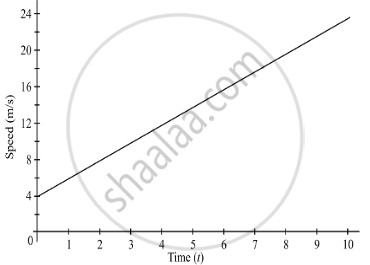Advertisements
Advertisements
प्रश्न
A car is moving on a straight road with uniform acceleration. The speed of the car varies with time as follows :
Time (s) : 0 2 4 6 8 10
Speed (m/s) : 4 8 12 16 20 24
Draw the speed-time graph by choosing a convenient scale. From this graph :

(1) Calculate the acceleration of the car.
(2) Calculate the distance travelled by the car in 10 seconds.
उत्तर
We have a velocity-time graph of a moving particle.

(i) We have to find the acceleration from the given graph.
Acceleration = slope of line
= `((12-4))/((4-0)) "m/s"^2 = 2 "m/s"^2`
(ii) Distance travelled by the car is given by the area enclosed by the curve.
s = `"(Sum of parallel sides)(Height)"/2`
= `((4+24)(10))/2` m
= 140 m
APPEARS IN
संबंधित प्रश्न
Under what condition(s) is the magnitude of average velocity of an object equal to its average speed?
Bus X travels a distance of 360 km in 5 hours whereas bus Y travels a distance of 476 km in 7 hours. Which
bus travels faster ?
Arrange the following speed in increasing order (keeping the least speed first
A scooter moving with a speed of 30 km/h.
A train starting from Railway Station attains a speed of 21 m/s in one minute. Find its acceleration.
An aircraft travelling at 600 km/h accelerates steadily at 10 km/h per second. Taking the speed of sound as 1100 km/h at the aircraft’s altitude, how long will it take to reach the ‘sound barrier’ ?
A car is moving along a straight road at a steady speed. It travels 150 m in 5 seconds:
What is its average speed ?
Which of the quantity-velocity or acceleration-determines the direction of motion?
A car is moving with a velocity 20 m s-1. The brakes are applied to retard it at a rate of 2 m s-2. What will be the velocity after 5 s of applying the brakes?
For the motion with uniform velocity , how is the distance travelled related to the time ?
Draw a diagram to show the motion of a body whose speed remains constant, but velocity changes continuously.
